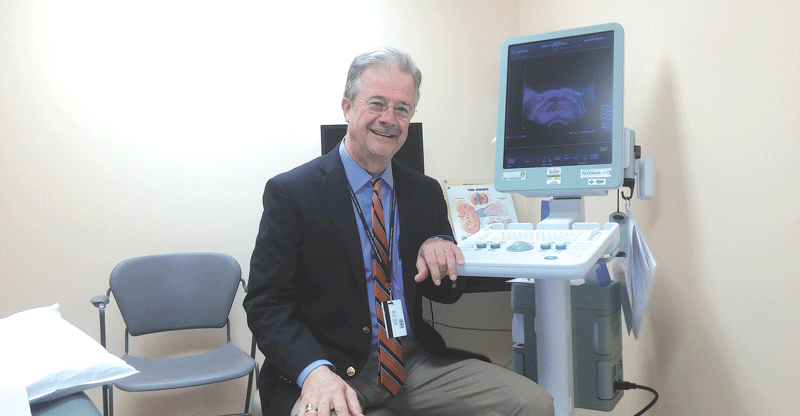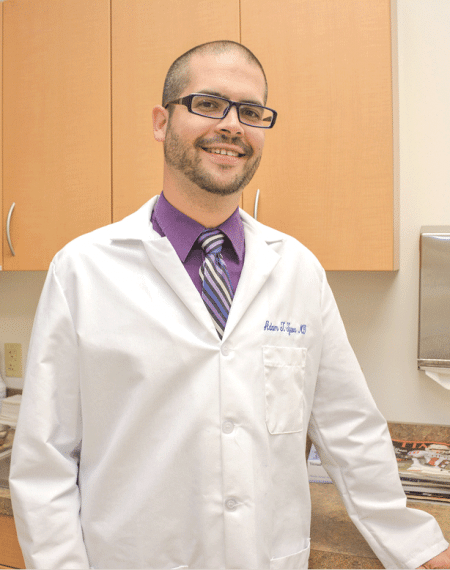Prostate Cancer Testing, Treatment Involve Personal Choice
Difficult Decisions

Dr. Richard Alexander says screening for prostate cancer has become controversial, but at least one study shows it extends longevity in people with the disease.
While much of what is known about prostate cancer is fact — including the fact that 99% of the men diagnosed with the most common forms of the disease will survive more than five years after diagnosis — there is still a good deal of conjecture. That’s especially true when it comes to screening for the malady.
One in seven men will be diagnosed with prostate cancer at some point in their lifetime.
“It’s a complicated disease, and a lot of issues surround it; doctors have devoted their entire careers to one subset of prostate cancer,” said Dr. Adam Tyson, a urologist at Urology Group of Western New England in Springfield.
Although it’s the second-most-common cancer in men and the second-leading cause of cancer deaths (skin and lung cancer, respectively, are number one), routine testing for the disease, which typically has no symptoms until it advances to the lymph nodes and bones, has become very controversial.
Screening involves a digital rectal exam and a simple blood test that measures the level of prostate-specific antigen, or PSA, which is a protein shed into the blood by the prostate gland that becomes elevated when cancer is present.
But in 2012, the U.S. Preventive Services Task Force declared that PSA testing should be abandoned. The reason is twofold: many men with elevated levels of PSA and an abnormal digital rectal exam have had biopsies that turned out to be negative, which caused unnecessary stress and did more harm than good; and arguments have been presented about whether routine testing increases survival rates.
Dr. Richard Alexander, a urologist at Baystate Medical Practices – Greenfield Urology, says a randomized study that followed a group of American men for 10 years found no difference in survival rates in men that were screened versus those not screened for the disease. But the problem with the study was that 70% of the men assigned not to be screened did indeed get screened outside of the study.

Dr. Adam Tyson says most prostate cancers are non-aggressive, so the doctor and patient have to work together to figure out the best way to treat the disease, which depends on a number of factors.
In contrast, a very large European study conducted in many countries showed routine screening did lead to an increase in overall survival.
“It is not an easy thing to determine, and the results were astonishing,” Alexander said, noting that prostate cancer is found most commonly in men age and 60 older who often have two or more other diseases as well due to their advancing age, among other factors.
It can only be diagnosed by a biopsy of the prostate, which is done in a doctor’s office through the rectum using ultrasound guidance.
Alexander noted that an elevated PSA level increases the chance that cancer could be present, but it can be elevated by other factors that range from an enlarged prostate to inflammation of the prostate gland.
Neither the digital rectal exam or PSA level is a perfect test, but the American Urological Assoc. feels screening can be valuable for men between the ages of 55 and 70, especially if they are at high risk for the disease due to a family history, as it has a strong genetic component.
“I don’t think all men should be tested. But at age 50, they should have a conversation with their doctor about it, and if they ask for my recommendation, I tell them to get it done,” Tyson said, explaining that, since it is often a slow-growing cancer, it doesn’t make sense to test men over the age of 75.
“A lot of the cancers are non-aggressive and may or may not catch up with people, so the question is how to find men with aggressive cancer and treat them. Many men get biopsies who don’t need them, but if they don’t, the only other time the cancer will be found is in the late stages. And although most men with prostate cancer are more likely to die with it, rather than from the disease, there are still 26,000 men who die every year from it, and if it doesn’t kill you, it can keep you from being able to urinate, or spread to the bones and lead to fractures.”
He noted that a biopsy can be recommended with an abnormal PSA or abnormal exam.
“Often, the PSA will be repeated to confirm accuracy if it is elevated. But depending on many factors, a urologist may recommend a biopsy with a single abnormal PSA or an abnormal digital rectal exam,” he continued, explaining that, although prostate cancer is rarely found in men under the age of 40, he has seen it in men in their 50s with some degree of frequency.
Personal Decisions
The American Cancer Society says about 180,890 new cases of prostate cancer will be detected this year, and about 26,120 deaths will result from it. However, if it is caught in the early stages, it is treatable, and 2 million men who are alive today are prostate-cancer survivors. In fact, 99% of men with the most common types of prostate cancer will survive more than five years after diagnosis, and when the disease is localized to the prostate or just nearby, which occurs 90% of the time, the prognosis is even better; almost 100% will live at least five years.
But there is a great deal of fear surrounding the disease as well as myths associated with it, including the perception that prostate-cancer surgery means an end to a man’s sex life.
“When I tell someone they have cancer, that word is almost always the only thing they hear during our first conversation,” Tyson said. “It’s a life-changing event, so people with the disease need to work closely with their doctors.”
Alexander says men have choices about what will happen to them, but they need to have a clear understanding of the issue before making any decisions.
“People are terrified of the word ‘cancer,’” he said. “But many men can live with prostate cancer their entire life, while in others it progresses, and although there is no way to accurately predict the future, predictions have become more accurate than they were in the past.
“I encourage men to be aware of their options and make informed decisions,” he continued, adding he frequently hears horror stories from men who had a relative with the disease. Their initial instinct is to base their decisions on anecdotal evidence about what happened to that person, but decisions need to be made carefully, and both he and Tyson believe in seeking second and even third opinions after a cancer diagnosis.
“There is a risk in doing anything, but there is also a risk in doing nothing,” Alexander noted.
Symptoms that occur when the disease has advanced include problems with urination, loss of appetite, weight loss, and metastatic disease, which is the name given to a cancer when it has spread to the lymph nodes or bones.
But the disease has different stages as well as grades, which refers to how the cells in the biopsy look under the microscope and can indicate whether the cancer is likely to progress.
There are four treatment options available today: radical surgery, radiation therapy, hormone therapy, and active surveillance, which can include additional biopsies every year or several years. The age of the patient and their overall health and willingness to be treated help determine what choice is best. But they all have their own risks.
“A radical prostatectomy removes the entire prostate and attached glands, and the main risk is urinary incontinence and erectile dysfunction,” Alexander said, adding that the surgery is done if the cancer is still confined to the prostate, and the success rate is high. As to side effects, although most men have some incontinence following surgery, few are left with a permanent problem.
Radiation therapy can be done with machines over a period of weeks, and side effects include more frequent urination, burns to the bladder or rectum, and erectile dysfunction. The therapy can also be delivered by implanting radioactive seeds into the prostate. The radioactivity is gone within a year, but the metal seeds remain. The procedure requires anesthesia and takes about an hour.
“But not everyone is a good candidate for the seeds,” Alexander said, adding that whether someone is a candidate depends on the stage of the disease and how likely it is that the cancer will spread.
Hormonal therapy is reserved for more advanced cases, but this treatment has come a long way: decades ago, it involved removing the testicles, while today it is administered through injections. Possible side effects include hot flashes, muscle loss, fatigue, and loss of bone density.
“In some cases, hormonal therapy is combined with radiation,” Tyson said, noting that is usually done only in the case of advanced disease.
And although some treatments do cause erectile dysfunction, the problem has been mitigated by drugs such as Viagra and Cialis, which can improve the quality of a man’s life.
“The way a man urinates after any treatment will shift, and since the nerves and blood vessels involved in an erection are attached to the back of the prostate, any treatment will affect it. Sometimes there is only an occasional weakening, but most men will need medications to regain potency,” Tyson explained.
The final option for men with cancer is to do nothing other than be followed closely, and this choice is becoming more popular in cases where the disease is considered low-risk. “We are finding that prostate cancer can often be watched for years and never progress,” Alexander said, adding that hundreds of thousands of men who have the disease may never know about it.
Final Recommendations
Despite conflicting opinions, Alexander believes men with abnormal PSA levels should have biopsies. “I would rather know I had the disease and make a decision not to have any treatment than not know I have it,” he said, adding that the decision is an individual one, and although in most cases prostate cancer is slow-growing, that’s not always the case, as evidenced by the number of deaths from it each year.
Advances in the field have been made, such as robotic surgery, which is less invasive, involves less blood loss, and allows men to recover more quickly than they did before it was invented.
“When people hear the word ‘cancer,’ they go into panic mode, but it’s important to understand the nature of the cancer because every cancer has its own way of behaving,” Tyson said. “Most prostate cancers do not spread rapidly and are non-aggressive, so the doctor and patient have to work together to figure out what is right for the patient. There is no single right answer; some people absolutely need treatment, and in others, it is less clear.”
Indeed, there is a lot of choice involved in the matter, but the first step — which is to get tested — is something every man should consider and talk to his doctor about.






